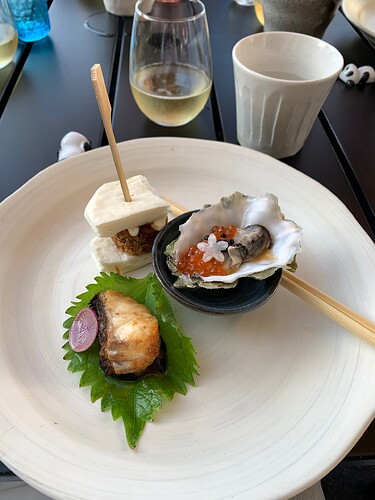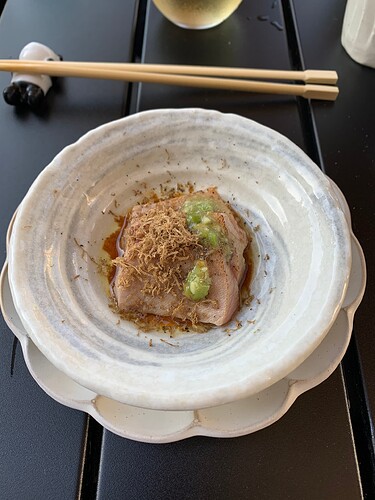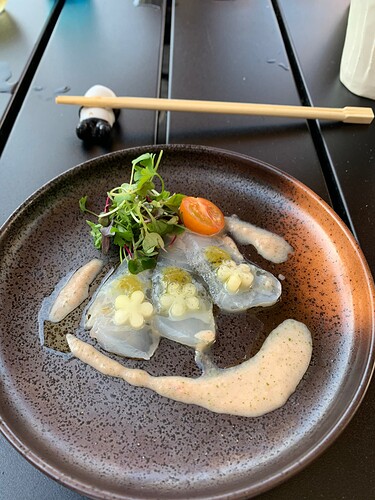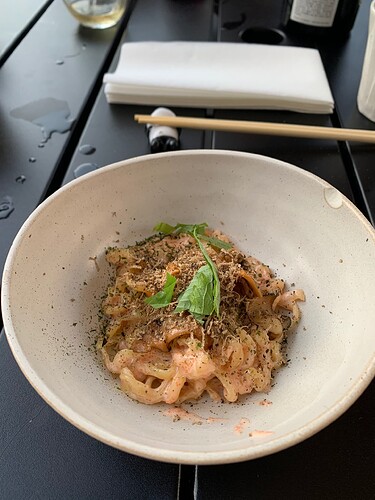The 169 is based on the 2013 vintage and is already a delightful version of this always enjoyable champagne. The 169 has some tart citrus flavors, sweet pear, brioche or backed apple flavors, just a hint of oak, a beautifully fine mousse, and a long deep finish. For such a young Grand Cuvée this is very, very fine.
Compared to the 168 we had a week ago at Iki Ramen in Koreatown ( Los Angeles) the 169 is more enjoyable currently.
FYI Iki Ramen on Western is a great place to try. We had the Kaiseki prix fixe which is predominantly sashimi, sushi, etc, and then a burnt garlic ramen near the end.
Iki is run by Jeffery Undiarto, and some others. We know Jeffrey from his time at N/Naka and this is definitely something that should be on your radar.
A few courses from Iki!!
Are you an avud drinker of GC? Can you make comparison from your point of view? between 169 / 68 and 67?
Thanks for the note. Last couple of bottles I had of 168 were shut down hard. Not touching any of my any time soon. Glad to hear 169 still seems accessible in its early days
That’s odd. Just had a 168 from 750 this week and it was great. Maybe not the best showing ever, but certainly not shut down hard or anything.
and great pictures!
Had some four bottles in the last two months. The first one was from my cellar and the others were from friends’ and one off a restaurant list. All the elements of a great champagne were there, but they all felt really disjointed and not integrated compared to bottles drunk earlier. That was the consensus each time we opened one. Maybe I’ve just had horrible luck with the bottles opened. I’m happy to drink it when others bring it, but but I’m not particularly inclined at the moment to drink from the stash in my cellar. I’d rather wait it out.
I would be more in Rodrigo’s camp regarding the 168. The bottle we had last week was somewhat disjointed. That being said it did compliment the food nicely (some rich Toro, A5 Wagyu, Yuzu, spicy ramen, etc.), and even when Krug does not show at its best , it’s still Krug ![]() .
.
Daniele,
Have not tried the 167 in some time, but it was a nice wine that drank pretty well young. No help on how it is drinking now.
168…we all need to wait at this point. I think it’s a bit like white northern Rhône (in structured vintage blends) Drink them fresh off the UPS truck or let them sit for 6+ years
Thanks for the feedback.
I drank 167 after roughly 1 year of release, 168 few months after release and 169 1 year after release (so a couple months ago).
I’ve tried them quite far a part in time and I’m still a newbie (and I was even more when i tried 167) but 169 is the one I liked more among the 3.
167 in my memory was leaner, fresher, sharper
168 was more round and buttery
When I tried 169 I felt like a perfect meeting spot between the previous 2 “positions”.
I wanted to know If some more experienced people felt the same
Daniele,
Krug GC is an interesting wine. Of the three versions one might suppose the 168, (base year 2012), might be the best as 2012 is considered a very high quality vintage. But it also could need more aging.
The 167, (base year 2011) is the weakest vintage of the three. But maybe Krug blended in more reserve wines which might make it an older overall blend and it could drink well younger.
The 169, (base year 2013) is also a very good vintage. And sometimes Grand Cuvée drinks well young and then sort of goes through a period where it seems disjointed and not as good as one initially remembers.
But the fun is trying different versions over time and seeing how they evolve.
I see you are from Milan. Can’t wait to get back! I speak acceptable Italian and my wife is fluent. It has been our decompress city on lots of vacations. Flight to Paris and then directly to Linate (hate Malpensa)!
Thank you for your kind answer!
I also had “hype” depending on the vintages, altho I was aware the idea is to blend it to be great every year despite what natrues throws at them.
167 was my first, you’d say “first love is special” or something like that but I preferred the young 168 over it and I liked the 169 better. I’d like to keep a yearly tradition of drinking the grand cuvee before the new one comes out (so roughly 12 months after release).
I don’t actually live in Milan, I reside in the provice (quite close to Malpensa) but I spend most of my quality time in Milan!
I like all three of these wines and agree that 167 is probably the most focused/precise, 168 the most fruity and creamy, and 169 the brightest, most citrus filled. I think the 168 has the most upside, but all are very good wines and all are wines that are going to change a great deal over the next 10, 20 and even 30+ years.
Replying to my own statement to say that it was maybe a bit dumb (as I was drinking champagne myself) I don’t think that we should keep our hands off for any period of Krug MV, just that I do think they evolve positively and most noticeably after 6 or so years. There is pleasure to be found on the whole curve though for sure.
Resurrecting this thread as I just had this last night. This was my first Krug so take this with mounds of salt, but I was quite surprised.
Based on everything I’d read about the ‘house style’, I was expecting something oxidative and broad, but this was super acid-driven and linear. Powerful, to be sure, but very sharp.
I left half the bottle in the fridge overnight to see how things evolve, but were my assumptions about Krug off-base, or is this just a reflection of the vintage?
Had the 168 last night…drinking very Krugy…and the shortest TN I can write…salted lemons and Fino Sherry.
That sounds like a representative 375 or 750 of 168. The magnums are drinking less acidic, less lemony, more orchard fruit, more creamy and nutty.
I think you have to be careful with reductive vs. oxidative and really define the meaning of what oxidative is or what style you are looking for. Wines made in a reductive, stainless steel environment can taste identical to wines made in a more oxidative, barrel aged environment - especially as they age. This can lead to a very reductive wine that has seen a lot of reserve wines or post-disgorgement aging tasting similar to a wine made in what would be defined as a more oxidative environment. Likewise, wines made in barrel, can still come across as reductive.
Krug really isn’t all that oxidative. The wine spends most of its life in a reductive environment. Put it in a lineup of other barrel aged or oxidative wines and it is a very quiet soul. There is a lot more that goes into the Krug style than the three months the wines spend in fairly old oak barrels.
Outside of the general statement of reductive vs. oxidative, I think you really need to define if you are looking for richness, bright fruit, spice, steely sharpness, creamines, etc…
For example, Vilmart is made in oak and the Coeur de Cuvee is made in a mix of new to 3 year old barrels. The wines do not come across as oxidative at all, but rather what I would classify as more reductive with spicy notes. Charles Heidsieck is reductive in style, but the wines can be quite rich and creamy. Pierre Peters is also more reductive in style, but with time or when you drink a wine of Rodolphe’s that has a good amount of reserves in it, you get something that is both rich, creamy, bright, fruity, and sharp.
Complicating things even more is that you need to look at how the winemaking is handled in terms of sulfur use especially at disgorgement. I’ve seen wines taste reductive in one environment and very oxidative in another based on the what I can only call mishandling at disgorgement. Low/No sulfur wines often don’t travel well internationally and that can lead to a wine tasting one way in Champagne and completely differently in North America.
Some classic producers who are on the purity side of things and reductive in style are: Piper-Heidsieck, Veuve Clicquot, Lilbert, Pierre Peters, Lancelot-Pienne, Laurent-Perrier, Billecart-Salmon, Guiborat, Gosset, and Ruinart.
On the richer, but still reductive side to me would be Charles Heidsieck, Dom Perignon, Taittinger, Roederer, A Margaine, Hure, Etienne Calsac, Vilmart, Hebrart, Geoffroy.
There are lots, lots more, but above is what popped to mind first.



